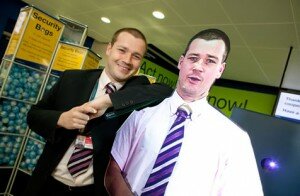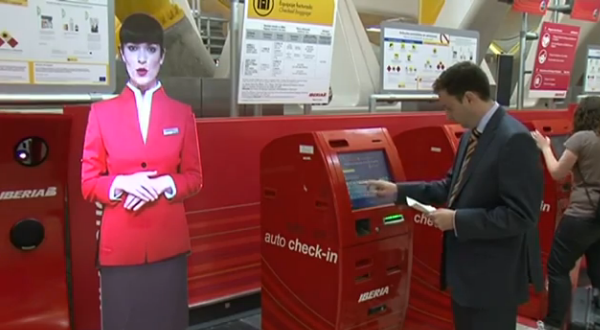The Rise of the Virtual Mannequins
From vending machines to supermarket self-service kiosks, companies have always strived to reduce staffing costs using automated customer facing technology. Increasingly, virtual mannequins (sometimes described as pseudo holographic staff or virtual assistants) are assisting/annoying customers in public areas around the globe.
![]()
This feature is brought to you in association with 3D specialists Presteigne Charter
Although the media often describe these systems as ‘holograms’, there is actually nothing ‘holographic’ about them. It might be more accurate to describe them as a form of digital signage.
The way the effect is achieved is simple. A recorded HD video of a person or animated character is rear projected onto a reflective film attached to a transparent glass/acrylic surface cut in to the shape of a person. Sometimes a pair of shoes is even positioned at the base and they tend to be life-sized. The film (for example, a film known as Vikuiti from 3M) is covered with glass bead lenses. When the image passes through the lenses from the projector, the beads have the effect of diffusing the light, giving a very wide viewing angle (nearly 180 degrees).
Airports are a popular home for the new two dimensional staff that don’t require sleep, nicotine reloading or possess the whiff of the morning after the night before.
 London Luton Airport claimed to be the first airport in the world to have introduced virtual mannequins after installing “Holly and Graham” to announce security information as part of a trial. Since then, Birmingham, Bristol, Edinburgh and Manchester airports have announced similar trials. Paris Orly airport introduced ‘virtual boarding agents’ and the Spanish airline Iberia have placed two virtual assistants by check-in kiosks at its Madrid-Barajas Airport hub.
London Luton Airport claimed to be the first airport in the world to have introduced virtual mannequins after installing “Holly and Graham” to announce security information as part of a trial. Since then, Birmingham, Bristol, Edinburgh and Manchester airports have announced similar trials. Paris Orly airport introduced ‘virtual boarding agents’ and the Spanish airline Iberia have placed two virtual assistants by check-in kiosks at its Madrid-Barajas Airport hub.
The Port Authority of New York has gone a step further by installing virtual mannequins that people can interact with. New York’s air travellers in each of the three main airports can ask questions such as “where is the baggage hall?” or “where the nearest human?” via voice recognition technology.
It is interactivity that a company called nuMedia Innovations hopes will revolutionise virtual mannequins. The company's technology allows people to interact via motion, sound and proximity sensors (as is described in the video below).
It was in the US that this need breed of customer service assistants entered the retail environment. New York pharmacy chain Duane Reade became the first retailer to roll out the holograms in the summer of 2011. At the time, a Duane Reade spokesman said: "It offers the store a wow factor. The virtual assistant is so compelling, shoppers are receptive to the wealth of information she provides, enabling them to get the big picture of everything the store offers in a very personal and exciting way."
Britain’s second biggest supermarket has recently been looking into this holographic style technology for marketing purposes. ADSA concluded a successful trial in January promoting the 10% price guarantee and speaking to The Grocer trade magazine, an ASDA spokeswoman said the trial had been "very successful and popular with customers" although no nationwide plans have been committed to yet.
Although such virtual mannequins have been making the news recently, it is important to note that similar systems have been in place for decades, based around real 3D mannequins. A good example was the Elan Valley Visitor Centre in Rhayader, Wales where a virtual ranger amazed and educated visitors.
"At the push of a button, visitors gave life to our 3D Ranger, his face would awaken and enthusiastically (as enthusiastic as a robot can be) told all about life in the Elan Valley” said Alan Samuel, Centre Manager. “We were sad to see him go when the exhibition was updated".
A mannequin was installed in a themed area of the centre with an artificial wooden rod concealing a projector. This projected a moving video of an actor’s head onto the head of the mannequin and, talking from a personal experience, it was incredibly effective and arguably more ‘3D’ than the current 2D systems.
The picture below is of the virtual ranger. We would like to say a special thank you to Alan Samuel from the Elan Valley Visitor Centre who spent the time finding this – there were no digital cameras in those days!
Skip forward a couple of decades and these virtual mannequins have moved on from visitor centres to being trailed for hospital infection reduction. A female virtual host stands in the Forth Valley Royal Hospital, Scotland relaying information on subjects including quitting smoking, the use of hand gel to stop infection and what’s on in the hospital’s restaurant.
There are cost benefits to replacing staff with virtual mannequins. Pro Screen Ltd, who provide virtual mannequins as part of their digital signage range, charge £5-7k per unit, a considerable saving compared to a human equivalent but the question is, how effective are they?
“We do have historical evidence now that the message, if delivered in a way that creates involvement or features a demonstration of a product , is being “watched” and that is evident in the uplift in leads generated at trade shows according to feedback from all of our clients”. said Andy Richardson, Sales Director of Pro Screen Ltd. “Whether any attention is paid at airports could also be asked of the human element doing the same job. I am not aware of any studies yet that would confirm that this is more or less proficient than a human person.”
However, “Holly and Graham” proved to be so successful at London Luton Airport that they were both given a 'permanent contract' .
“The aim of the holograms was to deliver a compelling “how to prepare” message, which, if successful, would result in fewer passengers needing to be stopped and searched” said a representative from London Luton Airport. “Since their introduction, the number of bags identified as being packed incorrectly has been reduced by at least 5% and we have had fantastic feedback from our passengers."
James Abdool from Media Zest backs up the positive response "From two clients that we have supplied virtual mannequins to, they have measured data to suggest that in an airport the VMs drove down the amount of water confiscated and the number of bag re-searches that were required which were key goals for implementing the virtual mannequins. In the other, a hospital, we understand that the VM has driven people to the areas that were talked about so we are confident that these are key tools with more than just a novelty factor."
Companies who provide such services believe there is a bright future for the virtual mannequins. Tensator (the company behind the London Luton trial) have suggested a virtual assistant could assist a shopper in the wine aisle by suggesting complimentary food for a bottle of wine after the scan of a bottle's barcode.
It is not just promotions, providing directions and entertainment virtual mannequins could be used for. More serious implementations are being considered. "We are now getting asked for security guards, and we have developed various “robot” caricatures that have been implemented in road safety campaigns and educational facilities” said Andy Richardson. "We are also passionate about the usages for the disabled especially the hearing impaired with whom we are developing a camera based “live” version via sign language transmitted over the cloud”.
Virtual mannequins are likely to become more common place in the future thanks to the cost savings. However, with such limited interactivity, it might be a while before they could replace ‘front of house’ staff in any significant numbers.
What do you think? Have you seen a virtual mannequin? Where you impressed? Do you think they are a good or bad thing for customer service? Let us know your thoughts below.
FREE WEEKLY 3D NEWS BULLETIN –























Pingback: The Rise of the Virtual Mannequins | Narrowcasting
Pingback: The Rise of the Virtual Mannequins | nuV-Host
Pingback: Virtual mannequins appearing everywhere, stealing jobs | Electronic Staff
Pingback: Virtual mannequins appearing everywhere, stealing jobs | Technical Jobs Today
Pingback: ‘Holographs’ appearing everywhere, stealing jobs | Mobile News Plus